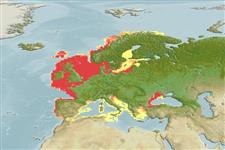>
Gobiiformes (Gobies) >
Gobiidae (Gobies) > Gobionellinae
Etymology: Pomatoschistus: Greek, poma, -atos = cover, operculum + Greek, schistos = divided (Ref. 45335).
More on author: Pallas.
Environment: milieu / climate zone / depth range / distribution range
ນິເວດວິທະຍາ
ສັດທະເລ; ນ້ຳກ່ອຍ ອາໄສຢູ່ໃກ້ໜ້າດິນໃຕ້ພື້ນທ້ອງນ້ຳ; ປາທີ່ມີການເຄື່ອນຍ້າຍຈາກທະເລໄປຫານ້ຳຈືດ ແລະນ້ຳຈືດຫາທະເລ; ລະດັບຄວາມເລິກ 4 - 200 m. Temperate; 8°C - 24°C (Ref. 4944); 71°N - 35°N, 11°W - 34°E
Eastern Atlantic: from Norway to Spain (Ref. 51442); also Mediterranean Sea (Ref. 51442) and Black Sea, but probably not throughout. Pomatoschistus minutus elongatus exists in the Mediterranean and the Black Sea.
Length at first maturity / ຂະໜາດ / ນ້ຳໜັກ / Age
Maturity: Lm 6.3, range 3 - 10 cm
Max length : 11.0 cm TL ຕົວຜູ້/ບໍ່ມີເພດ; (Ref. 4645); ອາຍຸສູງສຸດທີ່ເຄຍລາຍງານມາ: 2.70 ປີ (Ref. 40230)
ຄີ (ໜາມ)ແຂງຢູ່ຫຼັງປາ (ທັງໝົດ): 6 - 8; ຄີຫຼັງຂອງປາ (ຄີອ່ອນ) (ທັງໝົດ): 10-12; ຄີ(ໜາມ) ແຂງຢູ່ຄີກົ້ນປາ
ກຸ່ມປາກະດູກແຂງ
ຄວາມຖີ່ຂອງກຸ່ມຖ່າຍທອດພັນ
ປາທີ່ມີການເຄື່ອນຍ້າຍຈາກທະເລໄປຫານ້ຳຈືດ ແລະນ້ຳຈືດຫາທະເລ
ປາທີ່ມີການເຄື່ອນຍ້າຍຈາກທະເລແລະໄປໄຂ່ຢູ່ນ້ຳຈືດ
ຄີກົ້ນຂອງປາ
ສັດທີ່ມີກະດູກສັນຫັຼງ
ການຖ່າຍທອດທາງກຳມະພັນຈາກພໍ່ແມ່ຫາລູກ 1; ຄີກົ້ນຂອງປາ: 9 - 12; ສັດທີ່ມີກະດູກສັນຫຼັງ: 32 - 34. Elongated body (Ref. 51442). The relative great eyes are placed high and close together (Ref. 51442). Joint pelvic fins forming an oval ventral disc (Ref. 51442). Elongated caudal peduncle (Ref. 51442). Predorsal area and nape covered by scales (Ref. 59043). Scales on the back, in front of the first dorsal fin (Ref. 35388). Dark spot on the hind end of first dorsal fin; Dark area on the front part of pectoral fins indistinct or missing.
This occasionally schooling species is found in inshore sandy and muddy areas. Also found in ecotones near hard bottoms (Ref. 92840). Juveniles found in lower estuaries. Mainly diurnal, this species feeds on small polychaetes, amphipods (corophiids, caprellids), cumaceans and mysids (Ref. 4696). Spawns in summer in shallow waters. Male lures the female into an empty bivalve shell where she lays a portion of eggs. Guarded by the male for 10 days until larvae about 3 mm long. Larvae are pelagic at first. Young fish only start to live at the bottom when 17-18 mm (Ref. 35388).
High mortality rate during the first year. Also Ref. 53335.
Miller, P.J., 1986. Gobiidae. p. 1019-1085. In P.J.P. Whitehead, M.-L. Bauchot, J.-C. Hureau, J. Nielsen and E. Tortonese (eds.) Fishes of the North-eastern Atlantic and the Mediterranean. Volume 3. UNESCO, Paris. (Ref. 4696)
IUCN Red List Status (Ref. 130435)
Threat to humans
Harmless
Human uses
ການປະມົງ: ທີ່ບໍ່ມີຄວາມສົນໃຈ; ຕູ້ປາ: ບ່ອນວາງສະແດງສັນນ້ຳຂອງລັດ
ເຄື່ອງມື
Special reports
Download XML
ແຫຼ່ງອີນເຕີເນັດ
Estimates based on models
Preferred temperature (Ref.
123201): 7 - 12.2, mean 9.4 °C (based on 464 cells).
Phylogenetic diversity index (Ref.
82804): PD
50 = 0.5001 [Uniqueness, from 0.5 = low to 2.0 = high].
Bayesian length-weight: a=0.00631 (0.00462 - 0.00862), b=3.06 (3.02 - 3.10), in cm total length, based on LWR estimates for this species (Ref.
93245).
ຊັ້ນເຂດຮ້ອນ (Ref.
69278): 3.2 ±0.0 se; based on diet studies.
Generation time: 1.2 ( na - na) years. Estimated as median ln(3)/K based on 2
growth studies.
ຄວາມຢືດຢຸ່ນ (Ref.
120179): ຂະໜາດກາງ, ປະຊາກອນຕຳ່ສຸດທີ່ໃຊ້ເວລາສອງເທົ່າ 1.4 - 4.4 ປີ (K=0.93; tm=0.7; tmax=2.7; fec = 5,231).
Fishing Vulnerability (Ref.
59153): Low vulnerability (15 of 100).
Nutrients (Ref.
124155): Calcium = 101 [56, 258] mg/100g; Iron = 0.552 [0.269, 1.104] mg/100g; Protein = 18.2 [16.1, 19.8] %; Omega3 = 0.818 [0.358, 1.667] g/100g; Selenium = 11.6 [5.2, 35.1] μg/100g; VitaminA = 17.1 [4.9, 59.8] μg/100g; Zinc = 1.04 [0.71, 1.56] mg/100g (wet weight);
